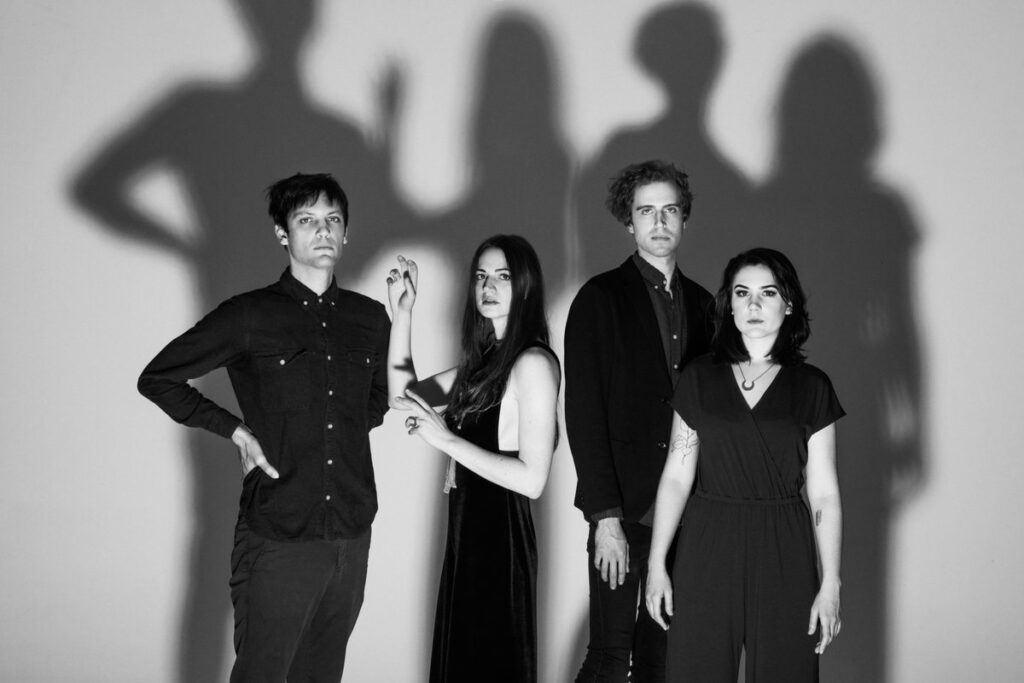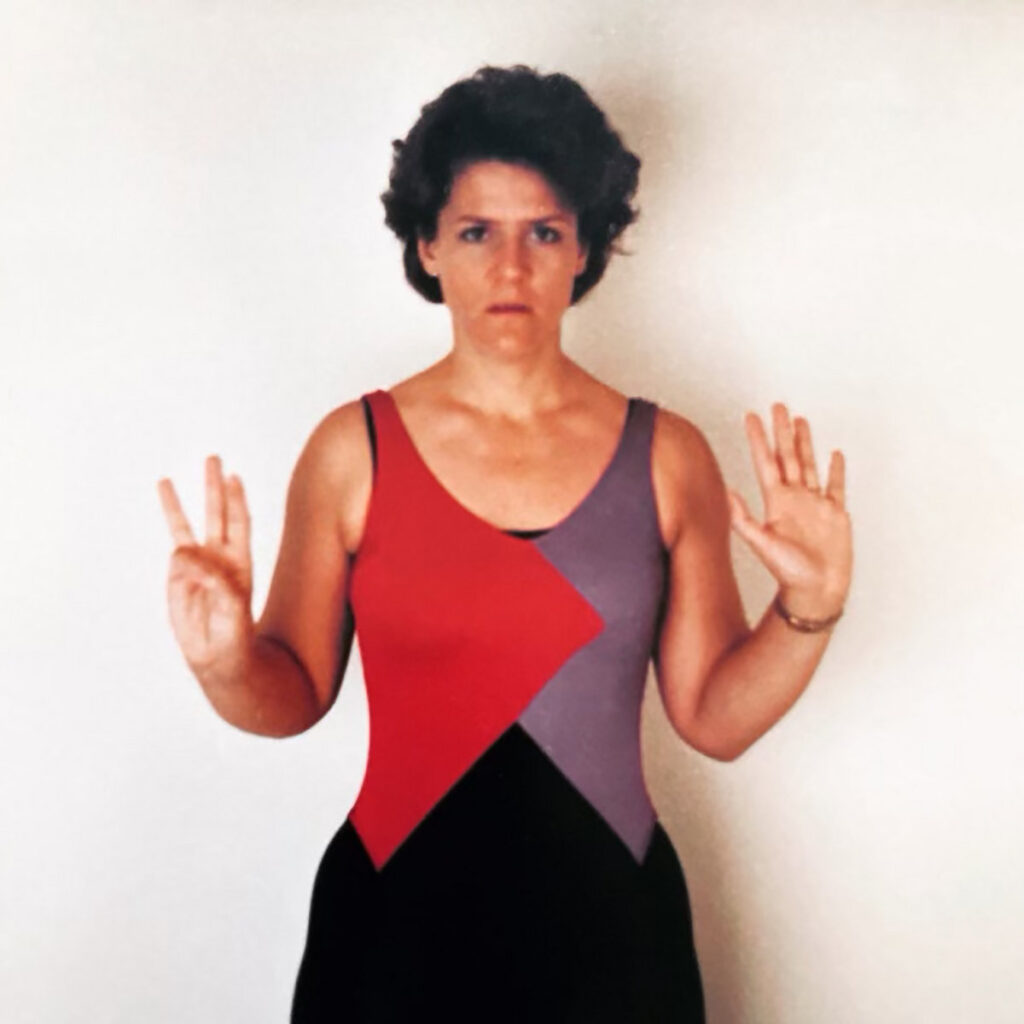
After over a year of pandemic-related delays putting a stop to live music, Brooklyn-based avant-rock band Activity is finally readying to go on their first tour. The group — comprised of singer and sample operator Travis Johnson and drummer Steve Levine from Grooms, guitarist Jess Rees from Russian Baths, and bassist Zoe Browne from Field Mouse — is setting out to perform across the continent for the first time, including a stop at Boston’s own Red Room at Cafe 939 on October 8th. The tour follows Activity’s debut record Unmask Whoever, which was released in March 2020 and blended dark, moody, synthetic textures with disorienting instrumental hazes, as well as a new single from the band ahead of these shows.
Released this week, “Text the Dead” is a track developed after the recent passing of Johnson’s mother in February from pancreatic cancer. About the song, Johnson says the following:
“I remember her telling me over the phone, when I was losing it, “Don’t worry, I’m not going anywhere.” I knew how awful the diagnosis was but I didn’t want to tell her and I really tried to cling to her telling me that. Throughout the day, still, I’ll catch myself thinking “I should tell mom about this or that” or “I wonder how my mom is doing” and get out my phone to call or text or email her before I realize that I can’t talk to her, and that I can’t talk to her about how I can’t talk to her. Knocks the wind out of me and makes me feel insane every time. That’s a picture of her when she was probably about my age on the cover. It was built on samples I’d put together and really mutilated a long time ago and forgotten about. I was going through old stuff and found it and started singing the verse melody.”

The cover for Activity’s “Text the Dead,” featuring a picture of vocalist Travis Johnson’s mother
Ahead of the single’s release, we talked with Travis Johnson about Activity’s formation, how “Text the Dead” developed from its nascent state, and Activity’s tour ahead.
Since Activity came together from other bands, what brought all four of you into one group to make music together?
Steve and I had played together before for a very long time in Grooms, and I got an itch to not do that band anymore, but I knew I wanted to keep playing with him. We had just started playing with Russian Baths and it was maybe Steve’s idea [to ask] Jess [if she wanted to play with us]. I think, the first couple times, it was like “maybe Grooms was gonna be over, maybe not.” We were still feeling it out a bit. Jess came over to our practice space, and it was just me and her, and we saw what it was like to play guitar together. And it went super well and was exciting. We started writing songs [with Steve] when Jess was like, “We need somebody else.”
Maybe a week after that, I was at a birthday party and Zoe was there and I asked if she’d be interested. I didn’t know Zoe all that well at that point, and I don’t think Zoe ever played bass before. She was a guitar player and a synth player. So it was like a “let’s do whatever we want” kind of thing. I wanted to start a band that felt like a clean break, even though I was still playing with one of the same people. I liked the idea of [going], “Yeah, learn how to play bass! I’m learning how to play a [new] sampler!” It was kind of like one friendship leading to the next member joining, and each time, it just happened that the first person that came to mind was great.
On that note, since you and Steve came from Grooms, but Jess and Zoe came from different bands, how did you bring together all your different backgrounds from different bands when forming this group?
I don’t actually know except that I like what everybody does. I don’t know how much of an influence the other bands [where Zoe] doesn’t play bass are on the way she plays bass [with Activity]. To me, it’s very creative and tasteful and kind of krautrock. And then Jess is able to do stuff in this band that she doesn’t do in her other band, which is maybe part of the way that it actually does influence things. She can play more textural, less riff-oriented stuff. Like, [Russian Baths has] a lot more riffs and chord progressions.
A lot of times [with Activity], it’ll literally be like I have a sample and made a loop. I’ll let it play, and all of us will play on top of it. Sometimes it’ll be just me and Jess — like if we’re the only two people who can play that night — and we’ll just be vamping on top of it for 45 minutes. Maybe it won’t get anywhere and we’ll never play it again, or we’ll be like, “It’s cool, the sample’s good, but we’re not getting anywhere.” But that’s something new that we both get to do in this band. I wanted to do more of that in Grooms, and it never happened.
Yeah, to me, you can sense that’s where things are starting to head on Grooms’ [last album] Exit Index. For you, what drove that idea to root things more around samplers and electronic percussion and more synthetic influences?
“Synthetic” is kind of a really important word I think about a lot [because] I want things to sound kind of not real. And not just like that it’s a synth, but that it actually just sounds fake. I had been getting in that mindset a lot with Grooms. I’d always liked stuff like that and I started to realize, with Grooms, everything we were putting out was hitting people as sounding like shoegaze — which I barely listen to — or Sonic Youth. I’d be like, “Oh, I’m not pushing certain elements of this as far as I [like]. It’s still not coming across.”
So with the new band, it was just like, “Well, let’s start there from the get-go.” There are some guitar-oriented, thoroughly rock songs, but that was kind of like the default setting for Grooms and we tried to push the synthetic stuff into that. With [Activity], every practice we set up the synths and we set up the sampler. Maybe [we’ll make] a guitar song, maybe it’s not. Maybe it’s the sound of someone singing into a mic, and then that gets looped and mutilated through effects. It’s just kind of a matter of starting in a different place.
Kind of centering things in a different place than trying to attack it consciously from the outside?
Yeah, exactly.
The Activity band bio says you started recording only six months after forming as a group. Can you talk about how the energy was when you all got together and how you came to know it was the right time to strike with recording?
A lot of it was just the way it worked out, which was that — right before Grooms ended — my friend Jeff [Berner, the band’s engineer], who I had actually just met, was like, “Hey, I’d like to record Grooms. I have a free day at the studio. Just come in and we’ll do a song.” And I was like, “This band’s going to end.” This was maybe even at our last show, I can’t remember. But I was like, “I might start something new.” So within six months of me, Jess, and Steve playing together, and three months of Zoe joining, we had a free day in the studio. So we got three songs ready — two of which made the album, and one came out as a B-side. And that right there got us into a mindset of what we could sound like in the studio with Jeff specifically, who understood our impulses and what we were thinking from the get-go. Then we booked [sessions for] the rest of the record a couple months later. There were probably eight more songs that we didn’t record or even try to record. It was really weird; I’ve never been in that situation before. Instead of it being like pulling teeth to get ten songs, we couldn’t even whittle it down.
Exactly the right creative energy, I guess.
Yeah, I mean, leave it to the listener to decide, but for us, it felt great.
Moving onto “Text the Dead,” you mention in the song description how you had returned to these samples you had been working with and developed the vocal melody from there. At what point in the process of working on the framework of the song did you know that the song would be about what it’s about?
In a way, immediately. Even now, I’m never not thinking about my mom. Like, just now, I was at the gym and thinking about her the entire time. So it would have been difficult for me to not write that at the time. But, a lot of the time, the way that I write lyrics is that, if a phrase grabs me, I’ll write it down and then I’ll think, “What is this about?,” and I’ll flesh it out from there. I can’t remember what the first line for this was — it might have been “You’re not going anywhere.” And I was like, “Well, I know what that’s about,” and then I worked outward from there.
But [for] the timing of when we were working on it, I was going home to Texas a lot to visit family right after my mom passed away. I was coming home and needed to quarantine because I had flown, and that was happening a bunch. It was right before I got vaccinated, and [my mom] had gotten her first shot. I was quarantining and was trying to make music, or trying to think about anything that felt helpful. That’s when I was like, “Oh yeah, this session!” I can’t even remember how old it was, but I was like, “Oh, this is great. Why did I never use this for anything?” And, at first, the melody just kind of happened there, and we finished recording it in June. So it wasn’t like a conscious decision, it just kind of happened that way. But given the timeline of when it came together, I don’t think there was any way it was going to be about anything else for me.
About the sound of the song itself, you mention in the track description taking samples and “mutilating” them. How do you transform these samples into the end product?
I’ll just go through songs sometimes and grab milliseconds of a sound, and then be like, “What does this sound like if I do this?” I think [“Text the Dead”] started with the drum track — there are like three or four drum layers on top of each other. It starts with one thing, and then another thing [comes in], and at one point there’s like three different samples going on top of each other. I think it was whatever that percussion was from that was the start of it. At some point, [I] probably dialed back some of the “mutilation” factor. I was like, “Oh, this is just too distorted.” [Laughs]
In terms of what the rest of the band brought to “Text the Dead,” how did they take the song from its framework and build upon it?
The first thing was that I sent it to people and was like, “Is this good?” And that might have even been before I recorded vocals for it. And everyone was like, “Yeah, this is cool. Let’s do something with it.” Everyone’s input was what we could do without access to a studio — we didn’t have time and maybe we also invited the limitation. So Steve came over with a snare drum and we mic’d the snare drum, and then he helped a lot with the vocal melody — which he’s never done before, I don’t think. And then Jess is kind of fluttering in and out guitar-wise throughout the song in ways that don’t always sound like guitar. And then Zoe came up with the chorus — I guess it’s a chorus, even though there’s only one of them. She came up with that melody, and then she and Jess doubled it. And that was kind of it. A lot of the first Activity album was like that too, where it was whatever anybody wants to add and then everybody will be like, “Yeah, that’s good, do more of that.” There wasn’t a lot of ego involved, and nobody was like, “Well, it has to be a full band performance.” There was no idea that had to be the case.
At this point, it’s been about a year and a half since Unmask Whoever came out and you’re just able to go on tour now. How have you as a band been keeping active in the time between that?
We’re pretty much ready, but we’re trying to figure out when we want to go in and record the next album. The three of us that all live within a couple blocks from each other started practicing, and Zoe — who lives in Connecticut — started coming down after we were all vaccinated. We were sending her voice memo recordings of what we were doing together. We had like twelve full-band songs, and then there’s another ten like sampler-y mode [of songs] — kind of like “Calls Your Name” on the first Activity album. So we have another twenty songs that we were working on, starting from whenever we started practicing. When we did [start practicing], it went very quickly. So, we just threw ourselves into that.
And then once we had the tour scheduled, we were like, “Which new songs do we want to play on tour?,” and got those down. To a certain extent, normal band stuff — except we couldn’t tour or record. It was a little like being in high school [and] being like, “We’ve got a band! And we have all these songs!” But you can’t get a show and you don’t have any money to go record in the studio, so you just kind of have these songs. So that’s where we’ve been for a while.
At the very least, I can imagine it gives you the time to develop things, even if everything else is less than ideal.
Yeah, it wasn’t a bad time, in a lot of ways, because there was nothing else to do. It wasn’t like, “Oh, I can’t practice for the next week because I’m going on a trip,” because there were no trips. There were no nights where anyone was like, “It’s date night,” or anything like that. So it was just a lot of time to sit and have long jam sessions, and a lot of time for me personally to sit in front of a computer and try to wrangle sounds into things that sound okay. It wasn’t a bad time in terms of that. Obviously, it was a horrible time in terms of everything else. But it was pretty conducive to being alone with your creative partners and just going for it.
Activity did a Bandcamp Friday tie-in a couple times where you would send song fragments in development out to people who bought stuff from you that day. Have any of those developed further than the form you sent them out in?
Yeah, I think at least one of them is like a song song that we still haven’t played on because it’s a sample / drum machine kind of thing. But the whole thing was completely from [going,] “Well, fifteen people bought the record yesterday. I want to make fifteen things that are good. They don’t have to be award-winning quality.” But some of them felt really strong and I was like, “I’m going to keep following this.” I felt kind of bad because some people were getting things that I [thought] were way better than the other things people got. I played all of [them] for Steve and was like, “Is any of this cool?” And he was like, “Oh yeah, even if it’s just fifteen or twenty or thirty seconds of this, as a segue or something.”
Actually, two songs that Jess sings [arrived] this way. That was totally just me being like, “Jess, too many people bought records! I need help! Can you write anything?” At least one or two of them were awesome, so those are new songs.
Since you have your first tour as a band coming up, how does it feel to finally be getting to perform these songs in a live space after waiting since the record came out?
I guess I don’t know yet. I’m really curious to see. I think it’ll feel amazing to play them, to hear a kick drum coming back through a monitor, or a venue with a good sound system. Or a venue without a good sound system! I think it’ll be a blast. I have no idea how many people even know we’re a band. [Laughs] But it’ll be interesting for sure. We’re really excited to do it and get to go live in a van together for a couple weeks.
Activity’s new single “Text the Dead” is out now. Stream it below via Bandcamp. Activity plays Boston at The Red Room at Cafe 939 on October 7th. Purchase tickets for the show here.
